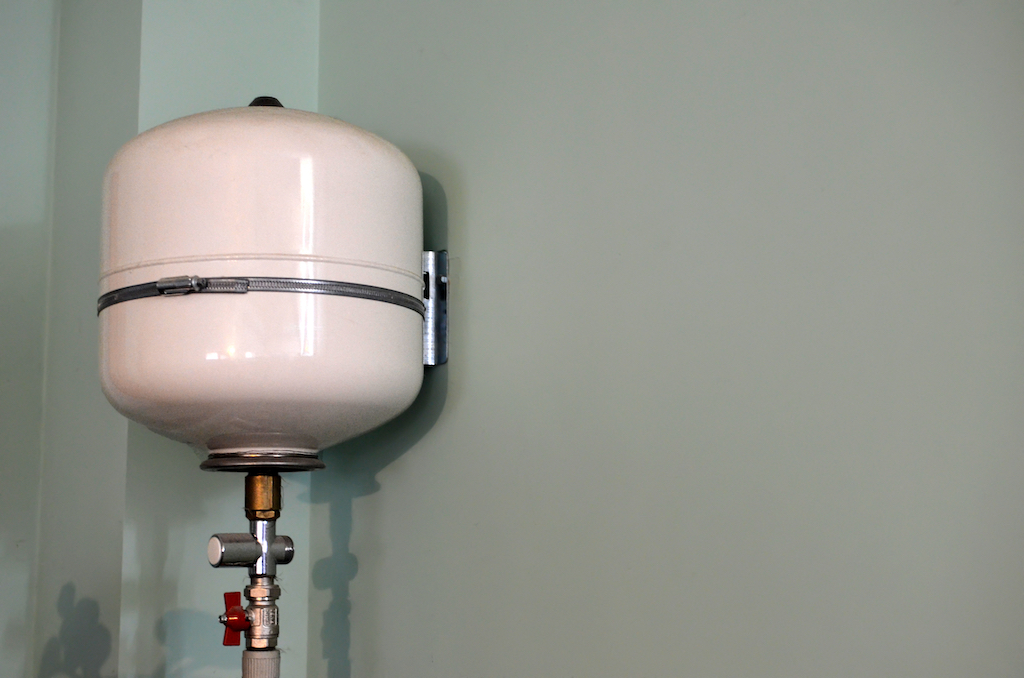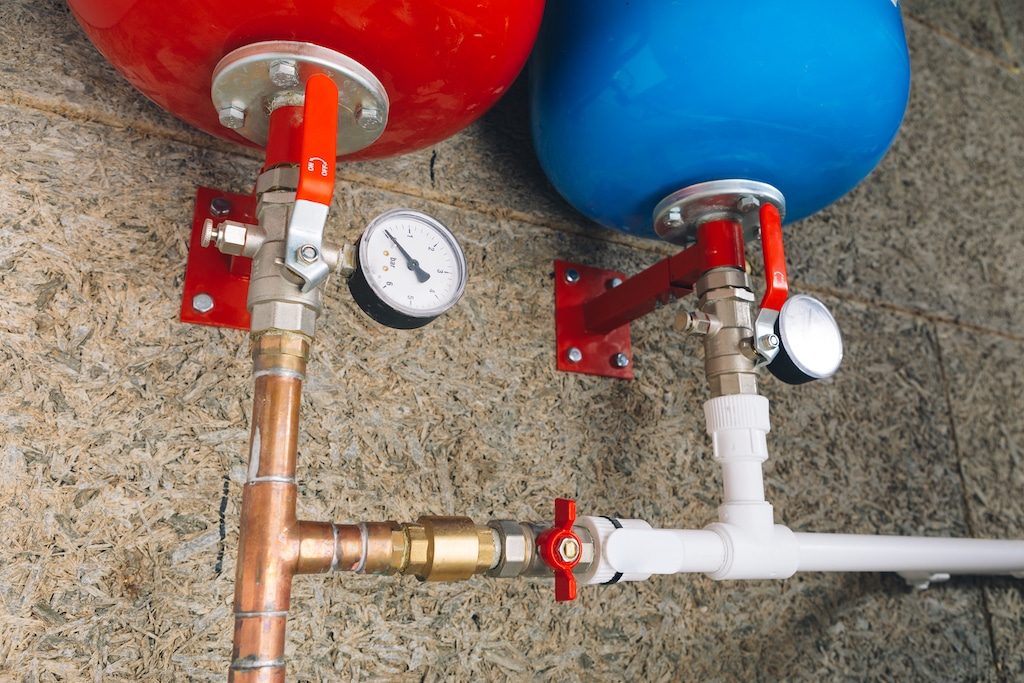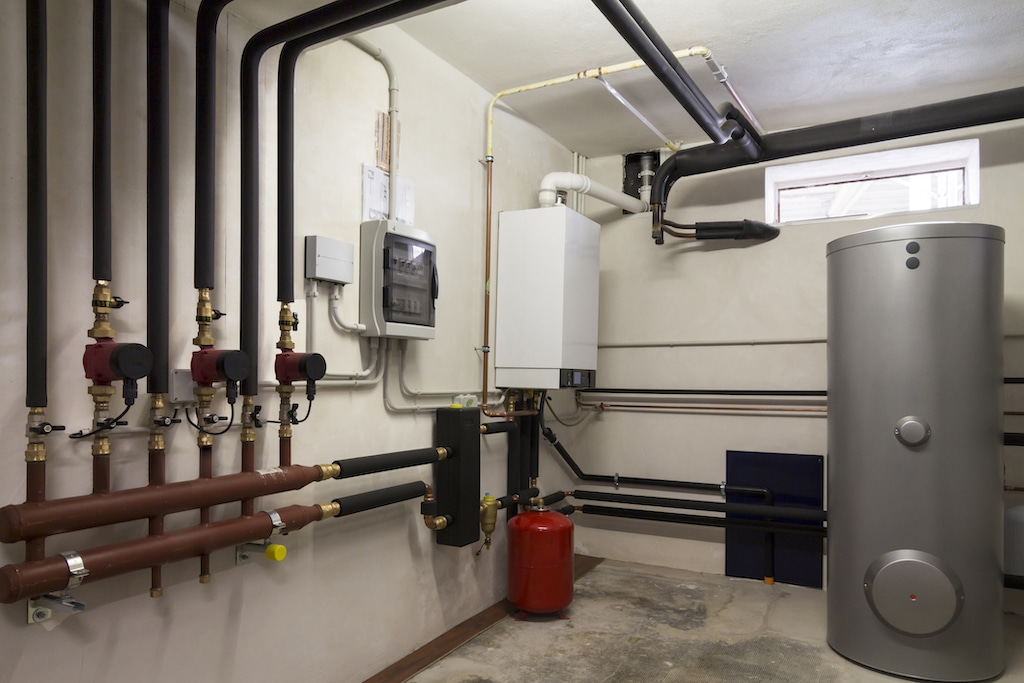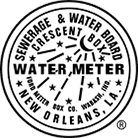
Water Heater Expansion Tanks: A Must-Read Guide
Have you ever wondered why your plumbing system needs a water heater expansion tank?
If you’re a homeowner, understanding the intricacies of your home’s plumbing can save you from future headaches. This article is tailored to shed light on the significance of water heater expansion tanks and how they contribute to the efficiency and safety of your water heating system.
In this article, we delve deep into the world of water heater expansion tanks, exploring their purpose, benefits, and essential maintenance tips.
Whether you’re a new homeowner or looking to upgrade your existing system, this guide provides valuable insights to help you make informed decisions.

Photo By nikkytok at ShutterStock
What is a Water Heater Expansion Tank?
A water heater expansion tank is a small but vital component in your home’s water heating system. Its primary role is to ensure the pressure within your plumbing remains at a safe level.
When water is heated, it expands, increasing the volume and, consequently, the pressure within your system. Without an expansion tank, this increased pressure could lead to potential damage to your plumbing fixtures, pipes, and the water heater itself.
The tank is typically installed on the cold water supply line near the water heater. It contains a pressurized air chamber that is separated from the water by a diaphragm or bladder.
As the water expands upon heating, it flows into the tank, compressing the air in the chamber. This action absorbs the increased pressure, preventing it from stressing the plumbing system.
Installing a water heater expansion tank is particularly crucial in closed water systems, where a backflow prevention device or a check valve is present.
These systems do not allow the excess water to flow back into the main city water line, increasing the risk of pressure buildup in your home’s system.
Regular maintenance of your expansion tank is essential to ensure its longevity and proper function. This includes checking the air pressure in the tank annually and inspecting for signs of leakage or wear.
If the tank is not functioning correctly, it could lead to a continuous operation of the pressure relief valve, water leaks, or even a burst tank, all of which could result in significant water damage to your home.
Understanding the importance of a water heater expansion tank and ensuring it is properly maintained can save homeowners from costly repairs and contribute to the efficiency and safety of the home’s water heating system.
Understanding the Functionality of a Water Heater Expansion Tank
The Role of the Expansion Tank in Pressure Management
The primary role of a water heater expansion tank is to serve as a safeguard against pressure increases within your home’s plumbing system.
When water is heated in your water heater, it expands, increasing in volume. This phenomenon, known as thermal expansion, can lead to a significant buildup of pressure within a closed plumbing system.
Without an appropriate mechanism to accommodate this extra volume, the pressure could escalate to a point where it damages pipes, joints, fixtures, or the water heater itself.
The water heater expansion tank acts as a buffer for this excess pressure.
It is designed with an internal diaphragm that divides the tank into two sections: one for water and the other for air. The air side is pre-charged with pressure, and as the water expands, it pushes against this diaphragm, compressing the air in the air chamber. This process effectively absorbs the increased pressure, preventing it from stressing the plumbing system.
How the Expansion Tank Protects Your Plumbing
By mitigating the pressure increase, the expansion tank plays a crucial role in protecting your plumbing system.
Excessive pressure can lead to various problems, such as leaks in your plumbing fixtures, burst pipes, or even the failure of the water heater itself.
The expansion tank helps to prolong the lifespan of these components by ensuring that the pressure within the plumbing system remains within safe limits.
Moreover, the presence of an expansion tank is particularly vital in systems where a check valve or pressure-reducing valve is installed. These valves can prevent the backward flow of water, making it even more crucial to have an expansion tank to accommodate the increased volume of heated water.
Maintenance and Efficiency
Regular maintenance of your water heater expansion tank is essential for its efficient operation. Homeowners should check the pressure in the tank annually and inspect it for signs of wear or damage.
A malfunctioning expansion tank can lead to continuous operation of the pressure relief valve, water leaks, or even a catastrophic failure of the tank, which could result in significant water damage.
Understanding the functionality of a water heater expansion tank and ensuring it is properly maintained is key to preserving the integrity and efficiency of your home’s plumbing system.
By providing a safe outlet for excess pressure caused by thermal expansion, the expansion tank is an indispensable component that helps maintain the balance and safety of your entire water heating system.
Also read: REVOLUTIONIZE YOUR HOME: TANKLESS WATER HEATERS – A COMPREHENSIVE GUIDE
Navigating the Installation Process of Water Heater Expansion Tanks
Embarking on the installation of a water heater expansion tank requires a nuanced understanding of the system’s dynamics and the specific needs of your home’s water heating setup.
This section delves into the critical steps and considerations to ensure a seamless and effective installation, enhancing the performance and longevity of your water heating system.
Pre-Installation Considerations
Before installing an expansion tank, it’s imperative to conduct a thorough assessment of your existing water heating system. This evaluation should include checking the water heater’s capacity, the system’s pressure settings, and the compatibility of the expansion tank with your water heater.
Understanding these parameters is crucial to selecting an expansion tank that aligns with your system’s requirements, ensuring it can adequately handle the thermal expansion and maintain optimal pressure levels.
Step-by-Step Installation Guide
System Shutdown
Begin by turning off the water heater and shutting off the water supply to prevent any water flow during the installation process.
Pressure Check and Adjustment
Before installing the expansion tank, check and adjust the air pressure to match the water pressure in your system. This alignment is vital for the tank’s effective operation.
Tank Positioning
Install the expansion tank on the cold water supply line, ensuring it’s securely mounted and in a location that allows for easy maintenance and inspection.
Secure Connections
Make all connections tight and secure, using appropriate fittings and sealants to prevent leaks. Ensuring airtight connections is crucial for the system’s integrity and effectiveness.
System Re-activation
Once the expansion tank is installed, turn the water supply back on and reactivate the water heater, checking for any signs of leaks or pressure issues.
Post-Installation Checks
After the installation of the water heater expansion tank, it’s essential to conduct a series of checks to ensure the system is functioning correctly.
Monitor the pressure levels and look for any signs of leakage or unusual noises, which could indicate issues with the installation. It’s also advisable to check the system periodically in the days following the installation to ensure everything is operating as it should be.
Professional Assistance
While some homeowners may feel comfortable undertaking the installation of an expansion tank themselves, seeking professional assistance can provide peace of mind and ensure the installation is performed correctly.
Professional plumbers have the expertise to handle any unforeseen challenges that may arise during the installation process, ensuring your system is set up for optimal performance and longevity.
By carefully navigating the installation process of a water heater expansion tank, homeowners can enhance the efficiency and reliability of their water heating system, ensuring it operates smoothly while protecting the system from the potential damages caused by thermal expansion.
Benefits of Installing a Water Heater Expansion Tank
Protection Against Pressure-Related Damage
One of the primary benefits of installing a water heater expansion tank is the protection it offers to your plumbing system.
The tank acts as a safeguard, absorbing the excess pressure generated when water is heated and expands. This function is crucial in preventing pressure-related damage to your plumbing fixtures and pipes, which can be costly to repair.
By mitigating the risk of leaks, bursts, and other stress-induced damages, an expansion tank ensures the longevity and reliability of your home’s plumbing infrastructure.
Extending the Lifespan of Your Water Heater
The water heater expansion tank plays a significant role in extending the lifespan of your water heater.
By managing the pressure within the system, the tank reduces the stress on the water heater’s components. This decreased stress helps prevent the premature wear and tear of the water heater, thereby extending its operational life.
Considering the investment involved in purchasing and installing a water heater, the addition of an expansion tank can be a cost-effective measure to maximize the appliance’s lifespan.
Enhancing System Efficiency and Reducing Energy Consumption
Another notable benefit of a water heater expansion tank is its contribution to the overall efficiency of your water heating system.
By ensuring that the system operates within optimal pressure ranges, the tank helps maintain the efficiency of the water heater, allowing it to heat water more effectively and with less energy waste.
This improved efficiency can lead to reduced energy consumption, which not only benefits the environment but also translates into savings on your energy bills.
Preventing Water Hammer and Noise Reduction
Water heater expansion tanks also help in preventing water hammering, a phenomenon where a shockwave is sent through the pipes, often resulting in loud banging noises. This can occur when there’s a sudden closure of valves in a high-pressure system.
The cushioning effect provided by the expansion tank helps to absorb these shockwaves, reducing the chances of water hammering and contributing to a quieter, more serene home environment.
The installation of a water heater expansion tank offers multiple benefits, from protecting your plumbing system and extending the lifespan of your water heater to enhancing system efficiency and reducing energy consumption.
These advantages underscore the importance of considering an expansion tank as a vital component of your home’s water heating system, ensuring its longevity, reliability, and cost-effectiveness.
Installation Tips for Water Heater Expansion Tanks
Proper installation is crucial for the optimal performance of a water heater expansion tank. Here are detailed guidelines to ensure your expansion tank functions effectively and efficiently.
Choosing the Right Size
Capacity Matching:
The size of the expansion tank should be compatible with the capacity of your water heater. A tank that’s too small won’t adequately handle the pressure fluctuations, while an oversized tank can be unnecessarily expensive and take up more space.
Consultation with Professionals:
It’s highly recommended to consult with a plumbing professional to determine the correct size. They can assess your system’s specific needs based on the water heater’s capacity and the overall plumbing system’s requirements.
Ensuring Proper Location
Close to the Water Heater:
The ideal location for an expansion tank is on the cold water supply line near the water heater. This proximity helps the tank efficiently manage the pressure from thermal expansion.
Accessibility:
Ensure the tank is installed in a location where it can be easily accessed for maintenance, inspection, and potential replacement.
Adhering to Manufacturer Instructions
Installation Guidelines
Following the manufacturer’s instructions is crucial for the safety and functionality of the expansion tank. This includes proper mounting, orientation (some tanks are designed to be installed vertically or horizontally), and securing the tank to prevent movement.
Connection Integrity
Ensure all connections are tight and leak-free. Use the appropriate sealing methods, like Teflon tape or pipe dope, to secure the connections and prevent leaks.
Adjusting Pressure Appropriately
Pressure Matching
Before installing the expansion tank, adjust its pressure to match the water pressure of your home. This is typically done with a standard air pump and a pressure gauge.
Checking System Pressure:
It’s essential to know your home’s water pressure, which can be measured using a pressure gauge attached to a spigot. The expansion tank’s pressure should be set to this value for optimal performance.
By following these detailed installation tips, you can ensure that your water heater expansion tank is set up correctly, enhancing the efficiency and longevity of your water heating system.
Proper installation helps in preventing pressure-related issues, ensuring that your plumbing system remains robust and reliable.
Troubleshooting Common Issues with Water Heater Expansion Tanks
Understanding how to identify and address common issues with your water heater expansion tank can save you from potential headaches and costly repairs.
Here’s a detailed look at how to troubleshoot some typical problems.
Addressing Water Leaks
Identifying the Source
If you notice water pooling around the expansion tank, it’s crucial to determine whether the tank itself is leaking or if the issue lies with the connections. Inspect the tank and fittings for any signs of moisture.
Bladder Failure
The most common reason for leaks in an expansion tank is a failure of the internal bladder. This component holds the air separate from the water, and if it ruptures, water will fill the entire tank, leading to leaks and a loss of functionality.
Replacement
Unfortunately, if the bladder is compromised, the entire tank typically needs to be replaced. Continuing to use a faulty tank can lead to increased pressure on your plumbing system and potential damage.
Managing Pressure Issues
Monitoring Pressure Fluctuations
If you’re experiencing fluctuating pressures or notice that the pressure relief valve on your water heater is frequently releasing water, it could be a sign that the expansion tank is not functioning correctly.
Pressure Adjustment
Check the air pressure in the expansion tank with a pressure gauge. If it’s too low or too high compared to your home’s water pressure, use a pump to adjust it accordingly. The tank’s pressure should be set to match the main water pressure when the system is at rest.
Replacement Considerations
Persistent pressure problems, despite correct adjustments, might indicate that the tank is no longer effective and may need replacing.
Resolving Noisy Operation
Identifying Noises
Noises like banging, humming, or gurgling from the expansion tank can indicate issues. Banging (water hammer) might occur if the tank’s air pressure is too low, while gurgling could suggest air has entered the water side of the tank.
Air Charge Check
Verify the air charge in the expansion tank. If it’s not at the correct pressure, adjust it. If the tank is waterlogged (full of water with no air cushion), this can also cause noise and requires draining the tank or potentially replacing it.
Professional Inspection
If the noise persists or you’re unsure about the cause, it’s wise to consult a professional. They can provide a thorough inspection and address any issues that might not be apparent to the untrained eye.
By regularly monitoring your water heater expansion tank and addressing these common issues promptly, you can ensure the longevity and efficiency of your water heating system, preventing minor issues from escalating into major problems.
Recognizing When Water Heater Expansion Tank Replacement is Needed
Understanding the lifespan and recognizing the signs that indicate the need for replacing your expansion tank can prevent potential damage and ensure the efficiency of your water heating system.
Assessing Age and Lifespan
Expected Lifespan
Expansion tanks typically have a lifespan of 5 to 10 years, although this can vary based on usage, water quality, and maintenance.
Age Evaluation
If your expansion tank is approaching or has surpassed a decade in service, it’s wise to have it assessed by a professional. Even if it appears to be functioning, internal components like the bladder may be nearing the end of their effective life.
Identifying Visible Damage
Rust and Corrosion
Check the tank for signs of rust or corrosion, which can compromise the tank’s integrity and lead to leaks. Rust is a clear indicator that the tank’s protective barriers have been breached.
Dents and Deformities
Physical damage to the tank, such as dents or deformities, can affect its ability to handle pressure fluctuations and might necessitate a replacement.
Wear and Tear
General wear and tear over time can weaken the tank’s structure and internal components, reducing its effectiveness and safety.
Monitoring Operational Failures
Pressure Maintenance
If the expansion tank is failing to maintain the correct pressure, it could be a sign of a malfunctioning bladder or valve, indicating the need for a replacement.
Bladder Rupture
A common failure in expansion tanks is bladder rupture. If the internal bladder is compromised, the tank will no longer function correctly and will need to be replaced.
System Impact
An ineffective expansion tank can put additional stress on your water heater and plumbing system, leading to potential failures elsewhere. If you’re experiencing related issues, it might be time to consider a new expansion tank.
Professional Assessment
Consultation
When in doubt, consult with a plumbing professional. They can provide an accurate assessment of your expansion tank’s condition and recommend whether a replacement is necessary.
Proactive Replacement
Being proactive about replacing your expansion tank can save you from unexpected failures and the potential for water damage or system inefficiencies.
By staying vigilant about the age, condition, and performance of your expansion tank, you can make informed decisions about its replacement, ensuring the continued health and efficiency of your home’s plumbing system.
Maintenance and Inspection of a Water Heater Expansion Tank
Importance of Regular Maintenance
Regular maintenance and inspection of your expansion tank are crucial for its optimal performance and longevity.
An expansion tank is integral to your home’s plumbing system, helping to manage pressure and prevent damage. Neglecting its maintenance can lead to system inefficiencies, potential damage, or even catastrophic failure, resulting in expensive repairs or replacements.
Annual Pressure Checks
One of the key maintenance tasks is the annual checking of the tank’s pressure. This involves measuring the pressure inside the expansion tank to ensure it aligns with the system’s requirements.
Typically, the pressure in the expansion tank should match the water pressure of your home’s plumbing system.
If the pressure is too low or too high, it may not function effectively, failing to absorb excess pressure from the system, which could lead to increased stress on your plumbing fixtures and water heater.
Inspection for Leakage or Damage
In addition to pressure checks, it’s essential to inspect the expansion tank for any signs of leakage or damage.
Over time, tanks can develop leaks or suffer from wear and tear that can compromise their integrity and functionality. Look for water stains, rust, or any signs of physical damage on the tank.
A leaking or damaged expansion tank can lead to water damage in your home and may not properly protect your plumbing system from excess pressure.
Professional Inspection
While homeowners can perform basic checks, it’s advisable to have a professional plumber inspect the expansion tank as part of your home’s routine plumbing maintenance.
A professional can conduct a thorough examination, including checking the tank’s internal bladder, ensuring the air and water sides are functioning correctly, and verifying that the tank’s pressure is adequately set. They can also provide expert advice on whether the expansion tank requires recharging, repair, or replacement.
Maintaining System Efficiency
Regular maintenance and inspection of your expansion tank contribute significantly to maintaining the efficiency of your plumbing system.
By ensuring that the expansion tank is functioning correctly, you can prevent unnecessary pressure buildup, reduce the risk of damage to your plumbing and water heater, and ensure that your system operates efficiently.
This proactive approach not only helps in extending the lifespan of your plumbing components but also contributes to energy savings and the overall health of your home’s plumbing system.

Photo By matteogirelli at iStock
Understanding Water Heater Expansion Tank Compatibility
Choosing the Right Expansion Tank for Different Water Heaters
When selecting a water heater expansion tank, it’s crucial to consider the type of water heater you have.
Whether it’s a traditional storage tank water heater, a tankless water heater, or a hybrid model, each has specific requirements that influence the choice of expansion tank.
The tank’s volume and pressure capacity should align with your water heater’s specifications to ensure optimal performance and prevent system failures.
Consulting with a professional can provide guidance on the best expansion tank for your specific water heating system, ensuring compatibility and efficiency.
Integration of Expansion Tanks with Renewable Energy Systems
With the growing trend towards renewable energy, many homeowners are integrating solar water heating systems or geothermal heat pumps with their domestic water systems.
In such setups, the water heater expansion tank plays a vital role in maintaining system pressure and preventing damage. For solar water heating systems, expansion tanks must accommodate the thermal expansion caused by varying temperatures throughout the day.
Similarly, geothermal systems require expansion tanks that can handle the pressure fluctuations inherent in their operation. Selecting the right expansion tank for these renewable energy systems is essential for their longevity and reliability.
Expansion Tanks and Water Quality: What You Need to Know
Water quality can significantly impact the lifespan and functionality of your expansion tank.
Hard water, which is high in minerals, can lead to sediment buildup inside the tank, affecting its operation and efficiency. In areas with poor water quality, it’s advisable to consider expansion tanks with corrosion-resistant materials or additional protective features.
Regular maintenance, including checking for sediment buildup and ensuring the tank’s internal bladder is intact, can help mitigate the effects of hard water on your expansion tank, prolonging its useful life and maintaining the efficiency of your water heating system.
By understanding these aspects of water heater expansion tank compatibility, homeowners can make informed decisions that enhance the efficiency and longevity of their water heating systems.
Whether you’re integrating an expansion tank with a traditional, tankless, or renewable energy-powered water heater, or dealing with specific water quality challenges, choosing the right expansion tank is crucial for maintaining a reliable and efficient water heating system.
Optimizing Your Home’s Energy Efficiency with Water Heater Expansion Tanks
The Role of Expansion Tanks in Energy Conservation
Water heater expansion tanks play a pivotal role in the energy efficiency of your home’s water heating system.
By mitigating the pressure caused by thermal expansion, these tanks help maintain the optimal operation of your water heater, which can lead to significant energy savings over time.
When a water heater operates without the risk of excessive pressure, it can function at its designed efficiency level, reducing the energy wasted on heating water and coping with pressure fluctuations.
An efficiently functioning expansion tank contributes to a balanced system where the water heater does not have to work overtime to heat water, thus conserving energy.
This balance not only prolongs the lifespan of the water heater but also ensures that it uses energy as effectively as possible, translating into lower utility bills and a reduced carbon footprint for the household.
Expansion Tanks and System Longevity
The installation of a water heater expansion tank directly impacts the longevity of your water heating system.
A system that operates under constant high pressure is prone to wear and tear, which can lead to premature failure of the water heater and associated plumbing components. By absorbing the excess pressure, the expansion tank reduces the strain on the water heater and the entire plumbing system, thereby extending their operational life.
Longer system longevity means fewer replacements and repairs, which not only saves money but also reduces the environmental impact associated with manufacturing and disposing of water heating systems.
By enhancing the durability of your water heating system, an expansion tank indirectly contributes to resource conservation and waste reduction.
Monitoring and Maintenance for Optimal Efficiency
To ensure that an expansion tank continues to contribute to the system’s energy efficiency, regular monitoring and maintenance are essential.
Checking the tank’s pressure, inspecting for leaks or damage, and ensuring that it is functioning correctly are all crucial steps in maintaining an efficient system.
Scheduled maintenance can identify and rectify issues before they escalate, preventing inefficiencies and potential system failures.
A well-maintained expansion tank supports the consistent operation of the water heater, ensuring that it does not consume more energy than necessary and maintains its designed efficiency level.
water heater expansion tanks are more than just components for pressure regulation; they are integral to the energy efficiency and longevity of your home’s water heating system.
By understanding and leveraging the benefits of these tanks, homeowners can enjoy not only a more efficient and reliable water heating system but also contribute to broader environmental conservation efforts.
Top 5 Best Practices for Water Heater Expansion Tanks
-
Expansion Tank Dos and Don’ts
Material Compatibility: HPAC Magazine stresses the importance of material selection for expansion tanks.
Combining steel with oxygen, especially in open-loop systems, can lead to corrosion. Opting for materials that resist corrosion ensures the durability and effectiveness of your expansion tank, preventing premature failure and maintaining the integrity of your water heating system.
Proper Installation: The article also underscores the necessity of correct installation practices. Using a standard expansion tank with a carbon steel shell in incompatible systems can lead to operational failures.
Ensuring that your expansion tank is suitable for your specific water heating setup is crucial for its longevity and efficiency.
-
Extending Water Heater Life
Comprehensive Maintenance: High 5 Plumbing provides a holistic approach to extending the life of your water heater. Regular maintenance tasks like flushing the system, testing pressure-relief valves, inspecting anode rods, and considering the addition of an expansion tank can significantly enhance your water heater’s performance and lifespan.
These proactive steps help in identifying potential issues early, preventing costly repairs or replacements.
-
Troubleshooting Expansion Tank Issues
Identifying Common Problems: Stallion Plumbing highlights common expansion tank issues such as venting water, air blockage, and corrosion. Recognizing these signs early can prevent more significant problems down the line.
Homeowners should be vigilant about these issues and seek professional help when necessary to ensure the expansion tank is functioning correctly.
-
Understanding Water Heater Types
Heat Pump and Hybrid Systems: While not directly related to expansion tanks, knowing the type of water heater you have is vital. Heat pumps and hybrid water heaters offer energy efficiency and cost savings.
The type of water heater influences the expansion tank’s requirements, underscoring the need for a system-specific approach to selecting and maintaining expansion tanks.
-
Integrating with Tankless Water Heaters
Optimizing Tankless Systems: The efficiency of 120-volt tankless water heaters can be enhanced with the correct integration of expansion tanks.
Water Heaters Now provides insights into how expansion tanks can complement tankless systems, ensuring optimal performance and longevity.
Understanding the interplay between different water heating solutions and expansion tanks is key to a well-functioning system.
These insights and strategies form a comprehensive guide for homeowners and professionals alike, ensuring the effective selection, maintenance, and troubleshooting of expansion tanks, ultimately contributing to a more efficient and long-lasting water heating system.

Photo By PeopleImages at iStock
How Bluefrog Home Services of New Orleans Can Assist with Your Water Heater Expansion Tank Needs
Comprehensive Water Heater Services in New Orleans and Surrounding Areas
Bluefrog Home Services of New Orleans is a trusted provider of water heater services, including expert assistance with water heater expansion tanks.
Catering to homeowners in New Orleans, LA, Harvey, LA, and Timberlane, LA, Bluefrog offers a range of services designed to ensure the optimal performance and longevity of your water heating system.
Expert Installation and Maintenance
Professional Installation
Installing a water heater expansion tank requires precision and expertise to ensure it functions correctly and complies with local building codes.
Bluefrog’s team of skilled technicians can provide professional installation services, ensuring your expansion tank is correctly sized and properly integrated with your water heating system.
Regular Maintenance
To keep your water heater expansion tank in top condition, regular maintenance is crucial. Bluefrog offers maintenance services to check the pressure levels, inspect for signs of wear or damage, and ensure the tank is functioning efficiently.
This proactive approach can help extend the lifespan of your expansion tank and prevent unexpected issues.
Troubleshooting and Repairs
Diagnostic Services
If you’re experiencing issues with your expansion tank, Bluefrog’s technicians can diagnose the problem, whether it’s pressure fluctuations, leaks, or operational inefficiencies.
Their expertise allows them to identify and address issues promptly, minimizing the risk of damage to your water heating system.
Repair and Replacement
Should your expansion tank require repairs or replacement, Bluefrog Home Services provides comprehensive solutions.
They can recommend and install a suitable replacement if your current tank is beyond repair, ensuring your new expansion tank meets your system’s requirements.
Local Expertise and Customer Satisfaction
Knowledge of Local Requirements
Understanding local building codes and regulations is essential for any plumbing installation or repair.
Bluefrog’s familiarity with New Orleans and surrounding areas’ specific requirements ensures that all services comply with local standards, providing peace of mind to homeowners.
Dedicated Customer Service
Bluefrog Home Services is committed to customer satisfaction, offering reliable and efficient services tailored to your needs. Their positive reviews and ratings reflect their dedication to quality service and customer care.
For expert assistance with your water heater expansion tank in New Orleans, Harvey, or Timberlane, contact Bluefrog Home Services at 504-229-4848. Their team is ready to provide the professional support you need to ensure the efficiency and reliability of your water heating system.
Conclusion
The role of an expansion tank in your home’s plumbing system cannot be overstated. This critical component not only ensures the longevity and efficiency of your water heating system but also plays a pivotal role in safeguarding your plumbing infrastructure from potential damage due to pressure fluctuations.
Regular maintenance, timely inspections, and understanding when to seek professional assistance for your water heater expansion tank are key practices that contribute significantly to the overall health of your plumbing system.
The water heater expansion tank acts as a buffer, absorbing excess pressure caused by the thermal expansion of water, thereby preventing undue stress on your plumbing fixtures and pipes.
Ensuring that this tank is functioning correctly is essential to avoid the risks of leaks, bursts, and other pressure-related issues that can lead to costly repairs and water wastage.
Engaging with professionals like Bluefrog Home Services for installation, maintenance, or troubleshooting can provide you with peace of mind, knowing that your system is in capable hands.
Their expertise can help in diagnosing and resolving any issues promptly, ensuring that your water heater expansion tank continues to operate efficiently.
We invite you to share your experiences or pose any additional questions you might have regarding water heater expansion tanks.
Your insights or inquiries could provide valuable perspectives or help others facing similar challenges. Share your thoughts below and join the conversation on maintaining an efficient and reliable plumbing system.

Photo By Imagesrouges at iStock
FAQs About Water Heater Expansion Tanks
1.What is the primary function of a water heater expansion tank?
The primary function is to absorb excess water volume when it’s heated, preventing pressure buildup in your plumbing system.
2.How often should I inspect my water heater expansion tank?
It’s recommended to inspect it annually for any signs of leakage or damage to ensure it’s functioning correctly.
3.How often should a water heater expansion tank be replaced?
While the lifespan of a water heater expansion tank can vary, it’s generally recommended to consider replacement every 5 to 10 years.
4.Can a water heater expansion tank improve the efficiency of my water heating system?
Yes, a properly functioning water heater expansion tank can contribute to the efficiency of your water heating system.
By maintaining the correct pressure within the system, the expansion tank helps prevent energy wastage and ensures that the water heater operates within its optimal performance range
5.What are the signs that my water heater expansion tank might be failing?
Several signs can indicate a failing water heater expansion tank, including visible leaks from the tank, noticeable rust or corrosion on the tank’s exterior, a waterlogged tank (where the tank feels heavy and full of water), or fluctuating water pressure in your home.
See our previous blog post.
Check out this tip!
Manny Mitten










